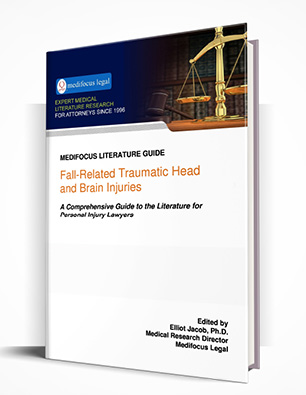Fall-Related Traumatic Head and Brain InjuriesA Comprehensive Guide to the Literature for Personal Injury Lawyers
Publisher: Medifocus Legal
Publication Date: January 31, 2017
Number of Pages: 137
A Comprehensive Guide to the Literature for Personal Injury Lawyers
Publisher: Medifocus LegalPublication Date: January 31, 2017
Number of Pages: 137
One of the most common types of injuries that can occur from a fall is a traumatic brain injury or TBI. A TBI can develop from any type of head trauma that disrupts the normal function of the brain. These types of brain injuries can range in severity from mild concussions that are characterized by a brief change in mental status to severe TBIs that are associated with an extended period of unconsciousness. In addition to TBIs, head trauma resulting from a fall has also been reported in the medical literature to cause other serious complications including subdural hematomas, extradural hematomas, arachnoid cysts, ocular motor nerve injuries, retinal hemorrhages, and post-traumatic cerebral infarction.
The MediFocus Literature Guide to Fall-Related Head and Brain Injuries is a comprehensive guide to the peer-reviewed medical literature for personal injury lawyers who will likely encounter cases involving a fall-related head or brain injury during the course of their legal practice. This unique Guide consists of over 140 hand-selected journal article references with links to the article abstracts and includes FREE online access to the full-text of 24 articles. Select topics from the Guide that will be of particular interest to personal injury lawyers include:
* Neuroimaging findings in patients with mild head trauma resulting from a fall.
* Risk factors associated with traumatic brain injuries during falls.
* Severity and outcomes of traumatic brain injuries from falls in adults.
* Fall-related traumatic brain injuries and the subsequent risk for developing dementia.
* The impact of age on functional outcome in adults with fall-related minor head trauma.
 |
- A comprehensive bibliography of 143 journal article references indexed in MEDLINE published in well respected medical and scientific journals.
- Online access to the abstracts (summaries) of the articles.
- Online access to the free full-text version of 24 articles.
- Links to full-text sources of other articles that are available for purchase directly from individual journal publishers.
- A unique "Author Directory" consisting of the names and institutional affiliations of experts who have published and have specialized knowledge about Fall-Related Traumatic Head and Brain Injuries. The "Author Directory" is a valuable resource for quickly identifying and locating experts for case reviews, opinions, and testimony.
Select examples of topics that are covered by the articles referenced in this Guidebook include:
- Injury patterns, severity, and outcomes among older adults who sustained brain injury following a fall.
- Falls and traumatic brain injury in adults under the age of sixty.
- Prevalence and factors associated with head impact during falls in older adults in long-term care.
- Injury and mortality associated with falls from heights.
- Work-related mild to moderate traumatic brain injuries due to falls.
- Factors associated with mortality and brain injury after falls from the standing position.
- Fall-related traumatic brain injuries in children.
- Diffusion-tensor imaging implicates prefrontal axonal injury in executive function impairment following very mild traumatic brain injury.
- Fall-related traumatic brain injury deaths and hospitalizations among older adults in the United States.
- Craniofacial injuries associated with slip, trip, and fall accidents.
- The use of accident reconstruction for the analysis of traumatic brain injury due to head impacts arising from falls.
- Fall-related brain injuries and the risk of dementia in the elderly.
- Nonfatal fall-related traumatic brain injury among older adults
- Pediatric fatal head injuries caused by short-distance falls.
- Fall-related upper body injuries in the elderly.
- CT scan findings in mild head trauma.
- Health-related quality of life and psychosocial consequences after mild traumatic brain injury.
is available in two formats: | |
Order by Phone:To order by phone, please call: Order by Mail:To order by mail, please print and complete this Order Form | |

